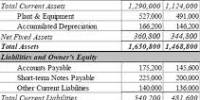Accounting Basics
Basic Accounting Model: Assets = Liabilities + Owners Equity
Assets: The following are examples of items classified as assets:
• Cash
• Notes Receivable
• Accounts Receivable
• Prepaid Expenses
• Land
• Buildings
• Equipment, Furniture and Fixtures
Liabilities: The following are examples of items classified as liabilities:
• Notes Payable
• Accounts Payable
• Accrued Liabilities
T-Account Basics: Accounting is based on a double entry system which means that we record the dual effects of a business transaction. Therefore, each transaction affects at least two accounts.
Debit: An entry affecting the left side of a T-Account.
Credit: An entry affecting the right side of a T-Account.
Increases in assets are recorded on the left side (debit) of the account.
Decreases in assets are recorded on the right side (credit) of the account.
Increases in liabilities and owners equity are recorded as a (credit).
Decreases in liabilities and owners equity are recorded as a (debit).
Accounting Terminology Defined:
Account Payable – A liability backed by the general reputation and credit standing of the debtor.
Account Receivable – A promise to receive cash from a customer for whom goods and/or services have been provided by the activity.
Accrual Basis Accounting – Accounting that records the impact of a business event as it occurs, regardless of whether the transaction affected cash.
Accrued Expense – An expense the business has incurred but not yet paid.
Accrued Revenue – A revenue that has been earned but not yet collected in cash.
Adjusting Entry – Entry made at the end of the period to assign revenues to the period in which they are earned and expenses to the period in which they are incurred.
Asset – An economic resource that is expected to be of benefit in the future.
Book Value of an Asset – The assets cost minus accumulated depreciation.
Cash Basis Accounting – Accounting that records transactions only when cash is received or paid. This methodology excludes receivables, payables and depreciation in its computation.
Chart of Accounts – List of all the accounts and their account numbers in the ledger.
Current Asset – An asset that is expected to be converted to cash, sold, or consumed during the next 12 months, or within the business’s normal operating cycle.
Current Liabilities – A debt due to be paid with cash or with goods and services within one year or within the entity’s operating cycle if the cycle is longer than one year.
Current Ratio – Measures the ability to pay current liabilities with current assets. Therefore, the ratio calculation is generated by dividing current assets over current liabilities.
Debt Ratio – This ratio measures the ability to pay for both current and long term debts (total liabilities). This ration is calculated by dividing total liabilities over total assets, and a lower debt ratio is more desirable than a high figure. As a rule of thumb, a debt ratio below .60 is considered generally safe while a debt ratio above .80 is considered risky.
Generally Accepted Accounting Principles (GAAP) – Accounting guidelines formulated by the Financial Accounting Standards Board (FASB) that govern how accountants measure, process and communicate financial information.
Journal – The chronological accounting record of an entity’s transactions.
Liability – An economic obligation such as a debt payable.
Liquidity – Measure of how quickly an item can be converted to cash.
Matching Principle – The basis for recording expenses this methodology directs accountants to identify all expenses incurred during the period, to measure the expenses, and to match them against the revenues earned during that same span of time.
Net Income – Excess of total revenues over total expenses. Also called net earnings or net profit.
Net Loss – Excess of total expenses over total revenues.
Note Payable – A written promise of future payment.
Note Receivable – A written promise for future collection of cash.
Posting – Copying amounts from the journal to the ledger.
Revenue – Amounts earned by delivering goods or services to customers.
Transaction – An event that affects the financial position of a particular entity and can be recorded reliably.
Trial Balance – A list of all accounts with their balances taken from the ledger used to ensure that total debits equal total credits.
Unearned Revenue – A liability created when a business collects cash from customers in advance of doing work. The obligation is to provide a product or a service in the future. Also called deferred revenue.
Financial Statements: Represent the manner in which transactions are presenting once they have been analyzed. The four basic financial statements to become familiar with are the income statement, balance sheet, statement of owners equity and statement of cash flow.
Income Statement: The income statement represents a summary of an entity’s revenues and expenses for a specific period of time, such as a month or a year. The income statement also called the statement of earnings or statement of operations represents a financial picture of business operations during the period. From a business perspective, one of the most important pieces of information provided by the income statement is “net income” calculated as revenues minus expenses. A positive net income indicates that operations for the period were favorable while a negative net income represents an unfavorable operational position.
Statement of Owners Equity: Represents a summary of the changes that occurred in the entity’s owners equity during a specific time period, such as a month or a year. Increases to owners equity arise from investments by the owner and from net income earned during the period. Decreases result from owner withdrawals and from a net loss for the period. Net income or net losses come directly from the income statement, and owner investments are capital transactions between the business and its owner, so they do not affect the income statement.
Balance Sheet: List all of the entity’s assets, liabilities and owners equity as of a specific date, usually the end of a month or a year. The balance sheet is like a snap shot of the entity and for this reason it is also called the statement of financial position.
Statement of Cash Flows: Reports the amount cash coming in (cash receipts) and the amount of cash going out (cash payments, disbursements) during a period of time. The statement of cash flows shows the net increase or net decrease in cash over a period of time and the cash balance at the end of the period.
















